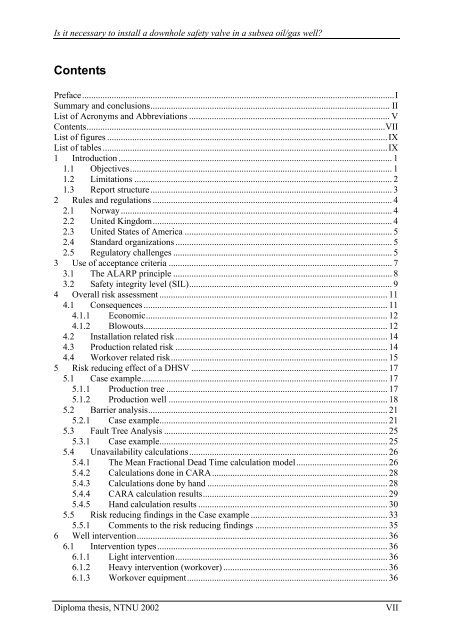Is it necessary to install a downhole safety valve in a subsea ... - NTNU
Is it necessary to install a downhole safety valve in a subsea ... - NTNU
Is it necessary to install a downhole safety valve in a subsea ... - NTNU
You also want an ePaper? Increase the reach of your titles
YUMPU automatically turns print PDFs into web optimized ePapers that Google loves.
<strong>Is</strong> <strong>it</strong> <strong>necessary</strong> <strong>to</strong> <strong><strong>in</strong>stall</strong> a <strong>downhole</strong> <strong>safety</strong> <strong>valve</strong> <strong>in</strong> a <strong>subsea</strong> oil/gas well?<br />
Contents<br />
Preface.........................................................................................................................................I<br />
Summary and conclusions......................................................................................................... II<br />
List of Acronyms and Abbreviations ........................................................................................ V<br />
Contents...................................................................................................................................VII<br />
List of figures ...........................................................................................................................IX<br />
List of tables .............................................................................................................................IX<br />
1 Introduction ........................................................................................................................ 1<br />
1.1 Objectives................................................................................................................... 1<br />
1.2 Lim<strong>it</strong>ations .................................................................................................................2<br />
1.3 Report structure.......................................................................................................... 3<br />
2 Rules and regulations .........................................................................................................4<br />
2.1 Norway....................................................................................................................... 4<br />
2.2 Un<strong>it</strong>ed K<strong>in</strong>gdom......................................................................................................... 4<br />
2.3 Un<strong>it</strong>ed States of America ........................................................................................... 5<br />
2.4 Standard organizations ............................................................................................... 5<br />
2.5 Regula<strong>to</strong>ry challenges ................................................................................................ 5<br />
3 Use of acceptance cr<strong>it</strong>eria .................................................................................................. 7<br />
3.1 The ALARP pr<strong>in</strong>ciple ................................................................................................ 8<br />
3.2 Safety <strong>in</strong>tegr<strong>it</strong>y level (SIL)......................................................................................... 9<br />
4 Overall risk assessment .................................................................................................... 11<br />
4.1 Consequences........................................................................................................... 11<br />
4.1.1 Economic.......................................................................................................... 12<br />
4.1.2 Blowouts........................................................................................................... 12<br />
4.2 Installation related risk............................................................................................. 14<br />
4.3 Production related risk ............................................................................................. 14<br />
4.4 Workover related risk............................................................................................... 15<br />
5 Risk reduc<strong>in</strong>g effect of a DHSV ...................................................................................... 17<br />
5.1 Case example............................................................................................................ 17<br />
5.1.1 Production tree ................................................................................................. 17<br />
5.1.2 Production well ................................................................................................ 18<br />
5.2 Barrier analysis......................................................................................................... 21<br />
5.2.1 Case example.................................................................................................... 21<br />
5.3 Fault Tree Analysis .................................................................................................. 25<br />
5.3.1 Case example.................................................................................................... 25<br />
5.4 Unavailabil<strong>it</strong>y calculations....................................................................................... 26<br />
5.4.1 The Mean Fractional Dead Time calculation model........................................ 26<br />
5.4.2 Calculations done <strong>in</strong> CARA............................................................................. 28<br />
5.4.3 Calculations done by hand ............................................................................... 28<br />
5.4.4 CARA calculation results................................................................................. 29<br />
5.4.5 Hand calculation results ................................................................................... 30<br />
5.5 Risk reduc<strong>in</strong>g f<strong>in</strong>d<strong>in</strong>gs <strong>in</strong> the Case example ............................................................ 33<br />
5.5.1 Comments <strong>to</strong> the risk reduc<strong>in</strong>g f<strong>in</strong>d<strong>in</strong>gs .......................................................... 35<br />
6 Well <strong>in</strong>tervention.............................................................................................................. 36<br />
6.1 Intervention types..................................................................................................... 36<br />
6.1.1 Light <strong>in</strong>tervention............................................................................................. 36<br />
6.1.2 Heavy <strong>in</strong>tervention (workover) ........................................................................ 36<br />
6.1.3 Workover equipment........................................................................................ 36<br />
Diploma thesis, <strong>NTNU</strong> 2002 VII


